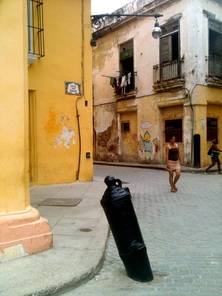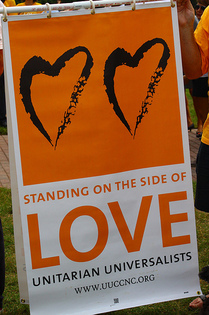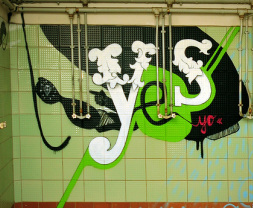
A corner in Old Havana / AlisonR
Vayas donde vayas, alli estaras.* Or so they might say in Cuba.
In airports, on tour buses, in hotels, restaurants, in Havana, Matanzas, Varadero, Cienfuegos, Trinidad and back at the Copacabana in Havana, I was much the same human being I had been in San Francisco except for swollen feet and ankles. In past travel, I had relied on avoidance-strategies to cope with the strange or disorienting. But this time, bolstered by 55 Tara Brach meditation podcasts, and a budding meditation practice, I was present; I was really there for the pleasant and unpleasant.
I was confused and anxious as we milled around the American Airlines Charter Flight counter at the Miami-Dade airport eager to enter Cuba and whatever awaited us just 90 miles from Key West.
The trip, organized by Global Exchange, was to encourage cultural sharing through choral music. We were a group of 74—the UC Alumni Chorus, Unitarian Universalist choir, 18 or so young Berkeley singers and a few like me who came along for the ride. I could go to rehearsals and performances, encourage the singers, be an appreciative audience or I could stay in an air-conditioned hotel room and read “The Tiger’s Wife” by Tea Obreht or listen to any of my Tara Brach talks.
There I was, present with my “All About Me” syndrome as I faced Cuban customs in Havana. Would I be the one among us ordered to open her suitcases? Would I have to explain my reading material? My large assorted collection of generic pills? Would they look askance at a coat lugged into extreme heat and humidity? Would a Cuban TSA tear out the lining in search of contraband? What about the stack of unworn underwear I planned to leave in Cuba as a sign of my goodwill to the people? Could anything be judged nefarious? If I am questioned, will it hold up the tour buses that wait outside Jose Marti Airport?
In fact, one of our group did delay our departure from the airport because in the spirit of goodwill she brought bottles of expired veterinarian medicines into the country, and airport officials were not happy. Finally, after an hour of sitting in the buses, their motors running, the air conditioning spewing perfumed air, we saw a tour guide go back into the terminal to bring Spanish into her side of the discussion to see if that might help her. The rest of us proceeded to the restaurant. Later, when the two joined us, we clapped. From goat to hero in time for lunch.
Because we got back to San Francisco late Friday night and I slept through most of Saturday, this brief account written Sunday can’t explore all I felt, saw and did those 13 days. But let me cover a few experiences, some of which required mindfulness to remain equanimous if travel were not to devolve into travail. For one, toilet paper is a luxury, not to be expected. Sometimes a lady would sit at the opening of the bano and sell pads of toilet paper for a small amount.** One soon learned to be self-sufficient. In fact my roll of Cuban toilet paper continued to serve me even after we had landed back in Miami at the end of the trip. Irony of ironies, my particular airport bathroom stall lacked toilet paper. And with left-over equanimity, I tittered about it.
Present to the dilemma of unpotable local water supplies and the specter of my plastic bottles cluttering the land fills, I developed an emotional attachment to large plastic botellas de agua from which I poured into multiple little botellas for easier transport as I strolled about the various courtyards or hung out in small stifling rooms listening to Arturo or Eliseo, our guides, translate lectures about state-sponsored music education. Did I always care? Was I always hot? Often thirsty? No, yes, yes.
In other posts I want to tell you more about experiencing Cuba as a member of a large tour group. These experiences are too piled up to unpack now and share from a place of response rather than reaction. For now, let me say that old cars do exist in Cuba, but so do newer cars – Fiats, Kia, Hyundai, and I even saw a Prius and a Toyota Corolla or two. The state does own almost everything, but that too is changing.
At about 1 a.m., finally home after a long day in the Miami-Dade airport, a five plus hour flight, and a three-hour time difference, I tried the key to the front door of my building. As the friends who brought me home drove away, I discovered the lock to the building had been changed while I was gone and the key didn’t work. And just then a third-floor neighbor pushed open the door so his darling dog, Cooper, could make his late night foray. Such luck. And so I was home, exhausted but still present with an overwhelming gratitude, or as we say en espanol, gratitud.
*As spoken in English by actor Peter Weller in the 1984 film The Adventures of Buckaroo Bonzai Across the 8th Dimension: “Wherever you go, there you are.”
In airports, on tour buses, in hotels, restaurants, in Havana, Matanzas, Varadero, Cienfuegos, Trinidad and back at the Copacabana in Havana, I was much the same human being I had been in San Francisco except for swollen feet and ankles. In past travel, I had relied on avoidance-strategies to cope with the strange or disorienting. But this time, bolstered by 55 Tara Brach meditation podcasts, and a budding meditation practice, I was present; I was really there for the pleasant and unpleasant.
I was confused and anxious as we milled around the American Airlines Charter Flight counter at the Miami-Dade airport eager to enter Cuba and whatever awaited us just 90 miles from Key West.
The trip, organized by Global Exchange, was to encourage cultural sharing through choral music. We were a group of 74—the UC Alumni Chorus, Unitarian Universalist choir, 18 or so young Berkeley singers and a few like me who came along for the ride. I could go to rehearsals and performances, encourage the singers, be an appreciative audience or I could stay in an air-conditioned hotel room and read “The Tiger’s Wife” by Tea Obreht or listen to any of my Tara Brach talks.
There I was, present with my “All About Me” syndrome as I faced Cuban customs in Havana. Would I be the one among us ordered to open her suitcases? Would I have to explain my reading material? My large assorted collection of generic pills? Would they look askance at a coat lugged into extreme heat and humidity? Would a Cuban TSA tear out the lining in search of contraband? What about the stack of unworn underwear I planned to leave in Cuba as a sign of my goodwill to the people? Could anything be judged nefarious? If I am questioned, will it hold up the tour buses that wait outside Jose Marti Airport?
In fact, one of our group did delay our departure from the airport because in the spirit of goodwill she brought bottles of expired veterinarian medicines into the country, and airport officials were not happy. Finally, after an hour of sitting in the buses, their motors running, the air conditioning spewing perfumed air, we saw a tour guide go back into the terminal to bring Spanish into her side of the discussion to see if that might help her. The rest of us proceeded to the restaurant. Later, when the two joined us, we clapped. From goat to hero in time for lunch.
Because we got back to San Francisco late Friday night and I slept through most of Saturday, this brief account written Sunday can’t explore all I felt, saw and did those 13 days. But let me cover a few experiences, some of which required mindfulness to remain equanimous if travel were not to devolve into travail. For one, toilet paper is a luxury, not to be expected. Sometimes a lady would sit at the opening of the bano and sell pads of toilet paper for a small amount.** One soon learned to be self-sufficient. In fact my roll of Cuban toilet paper continued to serve me even after we had landed back in Miami at the end of the trip. Irony of ironies, my particular airport bathroom stall lacked toilet paper. And with left-over equanimity, I tittered about it.
Present to the dilemma of unpotable local water supplies and the specter of my plastic bottles cluttering the land fills, I developed an emotional attachment to large plastic botellas de agua from which I poured into multiple little botellas for easier transport as I strolled about the various courtyards or hung out in small stifling rooms listening to Arturo or Eliseo, our guides, translate lectures about state-sponsored music education. Did I always care? Was I always hot? Often thirsty? No, yes, yes.
In other posts I want to tell you more about experiencing Cuba as a member of a large tour group. These experiences are too piled up to unpack now and share from a place of response rather than reaction. For now, let me say that old cars do exist in Cuba, but so do newer cars – Fiats, Kia, Hyundai, and I even saw a Prius and a Toyota Corolla or two. The state does own almost everything, but that too is changing.
At about 1 a.m., finally home after a long day in the Miami-Dade airport, a five plus hour flight, and a three-hour time difference, I tried the key to the front door of my building. As the friends who brought me home drove away, I discovered the lock to the building had been changed while I was gone and the key didn’t work. And just then a third-floor neighbor pushed open the door so his darling dog, Cooper, could make his late night foray. Such luck. And so I was home, exhausted but still present with an overwhelming gratitude, or as we say en espanol, gratitud.
*As spoken in English by actor Peter Weller in the 1984 film The Adventures of Buckaroo Bonzai Across the 8th Dimension: “Wherever you go, there you are.”
**About money. Tourists use CUCs, which is the convertible peso. We pronounced it “kooks.” Right now the exchange rate for $10 is 8.70 CUCs. (On November 8, 1994, the American dollar ceased to be accepted in Cuban retail outlets, leaving the convertible peso as the only currency accepted in many Cuban businesses, according to Wikipedia.)



 RSS Feed
RSS Feed